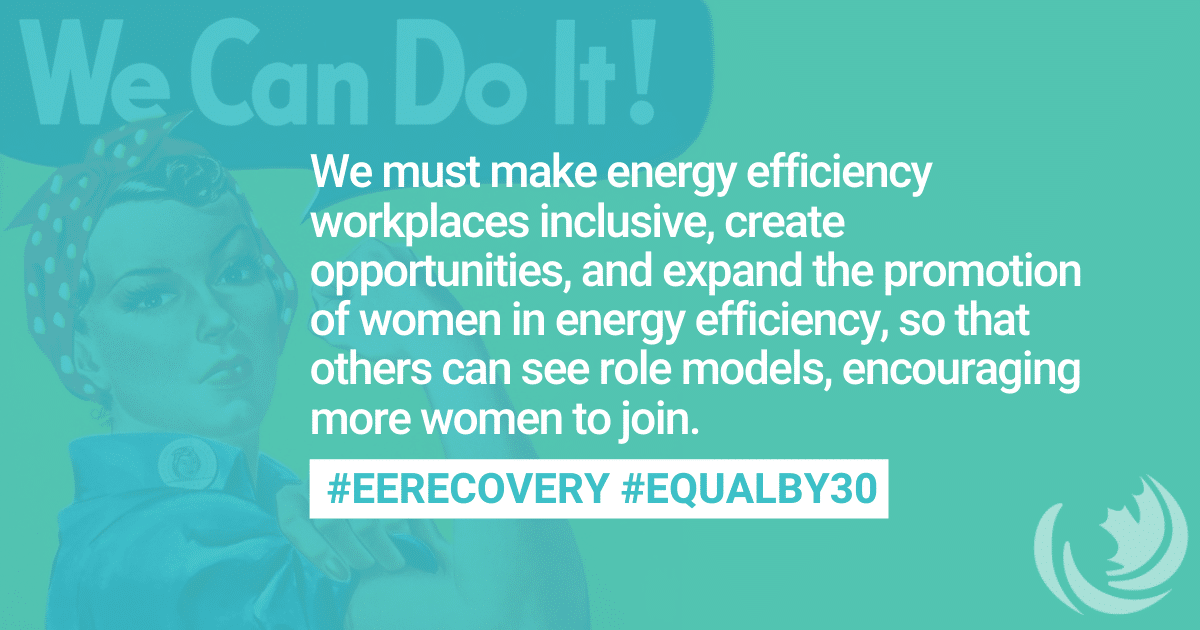Canada’s economic recovery could be a boon for women in the energy efficiency sector, if we play our cards right
There is much more to the sector than meets the eye
Gillian Wesley
Director of Communications
May 29, 2020
Blogs | News | Workforce Development
- The energy efficiency sector must develop strategies to increase participation of women in response to COVID-19.
- We can create opportunities for women to find better jobs in the trades and efficiency program delivery in a digital world.
- Efficiency Canada has joined other organizations in a mission to advance gender equality.
Perhaps, you too have noticed an increase in conversations around gender-based analysis and how COVID-19 is affecting women proportionately higher than men right now?
Economists are calling this the first “she-session,” given the high proportion of job losses in female-dominated service sectors. As a result, women are currently being affected more by employment loss as industry dynamics are amplified. With the spread of the COVID-19 pandemic, even the limited gains made in the past decades are at risk of being rolled back as a result of social, political and economic impacts that the pandemic is having on women and girls.
For those of us who work in energy efficiency, we need to think about this dynamic of the COVID-19 crisis, especially since under one-fifth or 18% of Canadian energy efficiency workforce reported to be female, making our sector less diverse than the national average. While there’s no denying that the efficiency sector has some big improvements to make to close the gender gap, I choose to see this as a great opportunity for other women to enter an untapped sector. This blog will focus on the opportunity that lies in energy efficiency for women – that is to advance their participation in the clean energy transition and what’s needed for this to occur.
If we hope to achieve gender parity, we must make a conscious effort to attract women to the workforce and create the right enabling conditions for women to enter. We must make energy efficiency workplaces inclusive, create opportunities, and expand the promotion of women in energy efficiency, so that others can see role-models, encouraging more women to join.
The power of role models
Beginning on a positive note, I am encouraged by the almost gender parity, that exists amongst the senior ranks of Canada’s leading energy efficiency program administrators and utilities. This includes executives such as Colleen Kuruluk, CEO of Efficiency Manitoba, Monica Curtis, CEO of Energy Efficiency Alberta, and Johanne Gélinas, Présidente-directrice Générale of Transition Énergétique Québec (TEQ).
I am further inspired by trailblazers, like Shawna Henderson, CEO of online-learning company Blue House Energy who is on a mission to boost the construction industry’s familiarity with the techniques and strategies needed to deliver better-performing buildings. As a 30-year industry veteran, who started her career as an energy advisor, Shawna is joining us on Friday, June 26th at noon (EST) for a Discover-EE session on “Becoming an Energy Advisor,” with the intent to inspire others, especially women, to follow this rewarding career path.
Enabling conditions
As we continue to build our economic recovery, we must also seize the opportunity to create a more equitable and inclusive workplace. Creating the right enabling conditions for women to enter new jobs in energy efficiency will require policy supports such as childcare, paid sick leave and family leave.
With over 51,000 Canadian business establishments in energy efficiency, small businesses are the backbone of the energy efficiency workforce. This presents an ideal area for the investment in policies that support women entrepreneurs to ensure economic recovery that will help to accelerate women’s careers.
There are also benefits to offering training specifically for women, and is an opportunity that should be explored.
Women in the trades
In a recent blog post, my colleague Brendan Haley, mentioned how specific emphasis should be placed on engaging women in the trades, to provide higher paying and more secure employment for those who have lost their jobs. Attracting women to these jobs will go a long way for Canada’s economy as a whole, as there aren’t enough skilled workers in Canada.
The trades offer well-paying jobs, when compared to existing female-dominated low-paying jobs, such as retail, hospitality, care, or administration work. Increasing women in trades also helps to combat the consequences many women face with part-time and temporary work such as few or no benefits, few opportunities for advancement, and greater risk of poverty. Draws of the trades professions include instant work and earning while you learn as an apprentice. In addition, the work-life balance is equally alluring to females as many job sites start early and finish by 3:00 p.m., which frees up late afternoons and evenings, and gives employees more flexibility.
In an effort to encourage un- and under-employed women (and men) to get into the skilled trades, Natural Resources Canada (NRCan) has provided a generous subsidy for certain online courses from the Canadian Institute for Energy Training (CIET) and the Heating, Refrigeration and Air Conditioning Institute of Canada (HRAI). Gender-specific training, that gets women up to speed on equal footing, is also an opportunity that should be explored.
Abundant career choices
Additional opportunities exist for women in a variety of roles, spanning from community engagement, communications and marketing, to technology and program design. Our Human Energy highlights a few of these roles in both urban and rural areas, across the country.
As we move into a more digital world under COVID-19, perhaps we will see an increase in remote work positions, such as virtual auditor, online educator, social media expert, or sales, all of which require skills where women have an advantage and experience. New opportunities in innovative marketing, data analysis, and citizen outreach techniques will be required to ramp up energy savings.
A mission to advance gender equality
We are not alone in our mission to advance gender equality in the clean energy sector writ large. Inspired by Electricity HR’s Leadership Accord, this week the Equal by 30 initiative of the Clean Energy Ministerial (CEM) celebrated their two-year anniversary. Over this time, they have been joined by over 145 signatories, ranging from private organizations to countries that have joined the global movement to move the dial on gender equality.
We are seeing women in leadership being spotlighted more. The Canadian Apprenticeship Forum hosted two sold out back-to-back, coast-to-coast conferences in 2019 on Supporting Women in Trades, EUCI’s women’s leadership in energy conference that was scheduled to be held in Toronto last April, and a female-inspired blog post by ACEEE on breaking barriers: women in energy efficiency tell their stories. Women-only networking events hosted by WiRE presents a welcoming and casual opportunity for women to meet peers, share ideas and opportunities, and educate colleagues about projects and initiatives of interest to the group.
StepUp is on a mission to assist organizations involved in energy management to better attract, retain, and advance mid-career women to C-suite and board positions. Speaking of which, they have three current board member openings, for interested women or men.
Join the conversation
With more companies focusing on gender equality, I can’t help but be reminded of the “We Can Do It!” poster produced by J. Howard Miller in 1943 for Westinghouse Electric as an inspirational image to boost female worker morale during World War II that has since turned into an iconic self empowerment image for the women’s movement. Perhaps it’s time for it to make another come-back? The immediate response to COVID-19 and subsequent clean energy recovery requires a war-time mobilization. Let’s make sure this is an empowering one for women.
Let us know how your organization is supporting equal pay, equal leadership and equal opportunities for women in clean energy by joining the conversation on LinkedIn.


